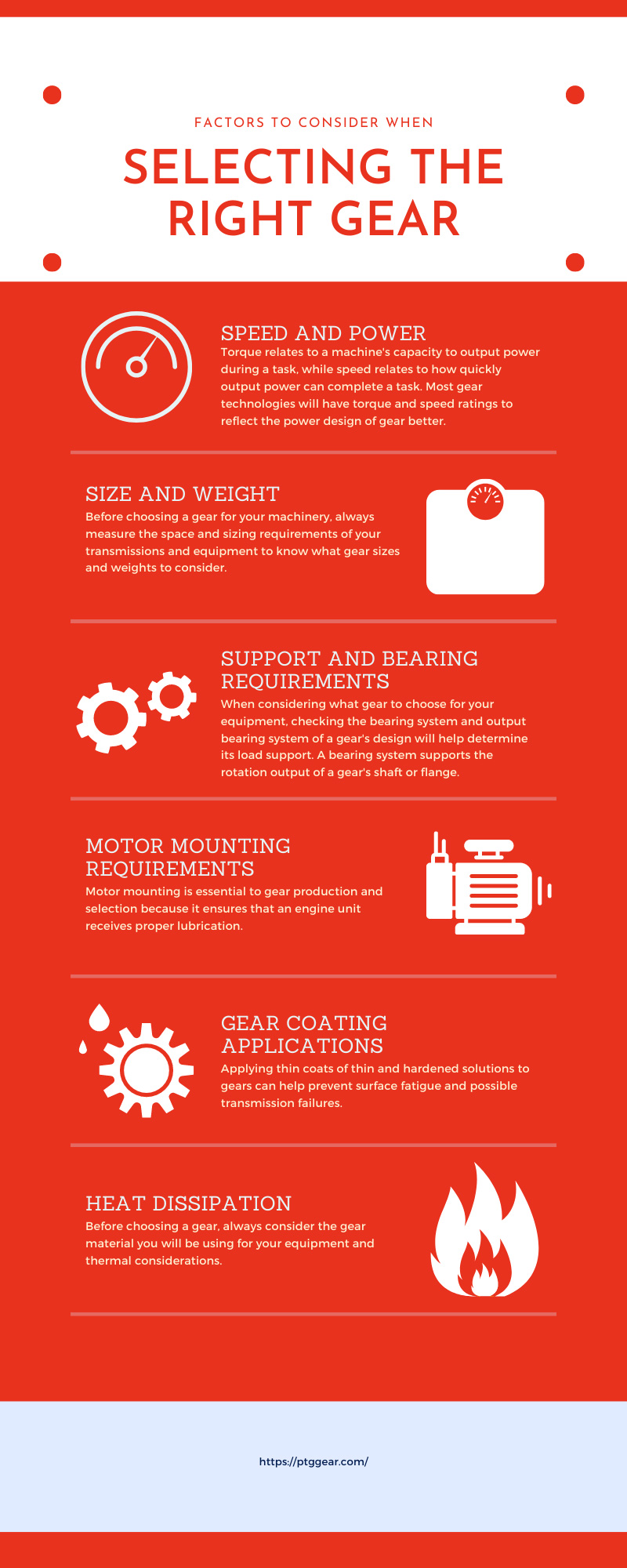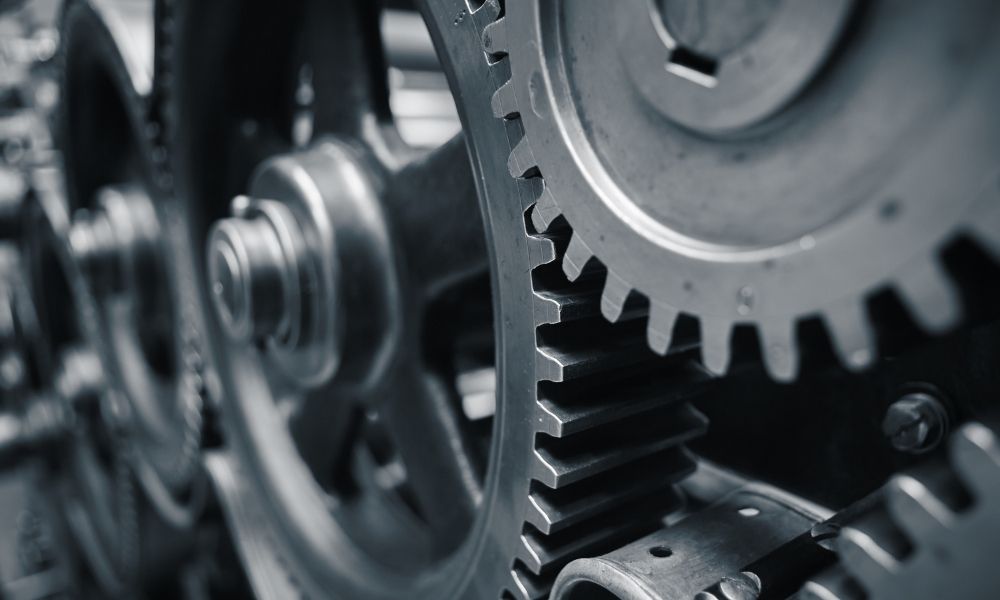Finding the right gears to support your machinery requires examining design, movement, and accuracy to ensure you’re working with the highest-grade gear technology. Before you decide between gears, start by reviewing the needs of your equipment.
Does your equipment need an upgrade in power and speed, or are dependable load support and precision your end goal? Once you've established your machine equipment's greatest needs, you can begin to identify what factors to consider when selecting the right gear.
Speed and Power
One of the most crucial factors to consider when selecting the right gear for your equipment is power. When you examine a gear's design power, you get a better sense of a motor's speed and torque.
Torque relates to a machine's capacity to output power during a task, while speed relates to how quickly output power can complete a task. Most gear technologies will have torque and speed ratings to better reflect a gear's power design. These ratings are calculated differently depending on technology and equipment type.
Materials
When choosing a gear from your equipment, consider what materials would create the best compatibility for your gears and machinery. Gears can be produced and manufactured with a wide variety of ferrous, non-ferrous, and plastic materials.
Ferrous materials can include steel, carbon steel, ductile iron, and alloy steel. Non-ferrous gears include copper, aluminum, brass, zinc, tin, and lead materials. Plastic gear systems are produced from phenolic resin, nylon, and Delrin. Identifying what material will create the highest compatibility level between your technology and gears will create a more efficient power equipment piece.
Size and Weight
The size and weight of gears will primarily affect the performance and assembly of gear transmissions. Before choosing a gear for your machinery, always measure the space and sizing requirements of your transmissions and equipment to know what gear sizes and weights to consider.
Customizability
When looking for different types of gears for power equipment, always prioritize the customization of gears. Whether your gears require a specific design and need to meet certain power or speed requirements, custom gear manufacturers are a vital resource. Custom gear manufacturers create the best personalized gears to meet your specific transmission and power needs.
Custom gear manufacturing is also capable of engineering older gears and recreating updated gears to improve efficiency. Before selecting a gear, always examine how it may be customizable to meet your power technology equipment's specific needs.
Support and Bearing Requirements
When considering what gear to choose for your equipment, checking the bearing system and output bearing system of a gear's design will help determine its load support. A bearing system supports the rotation output of a gear's shaft or flange.
Output bearing systems refer to the tilt of gears when subjected to high levels of rotation. These two calculations will reflect the gear's bearing load capacity, otherwise known as its accuracy rating. The size of the gearhead is also commonly based on the load capacity of the gear design.
The Duty Cycle
The duty cycle of a gear's transmission refers to the build-up of condensation created over the life of a transmission's use. Duty cycles reflect the dependability of bearings and gears because their condensation calculates their usage over time.
The duty cycle essentially is the measurement of a gearbox's life before a transmission inevitability dies. Checking the duty cycle of machinery better informs what type of gear to choose. For example, duty cycle engines with less use will be most compatible with smaller transmissions.
Motor Mounting Requirements
Motor mounting is essential to gear production and selection because it ensures that an engine unit receives proper lubrication. The motor's position will also estimate the reliability of a motor's distance between intersecting gears to ensure that gears can function efficiently together with ample spacing. Although gears' mounting requirements may seem like an afterthought, engines cannot run effectively if gears are mounted in incorrect positions.
Gear Coating Applications
When finding the right gear for your equipment and transmissions, assess whether gear coating applications should be used to prevent surface fatigue. Surface fatigue can occur on gears when they experience micropitting due to a lack of lubrication or excessive grinding against other gear surfaces over time.
Applying thin coats of thin and hardened solutions to gears can help prevent surface fatigue and possible transmission failures. If your machinery requires a high friction use of gears, or your gear material is more malleable over time, consider customizing a gear with a coating application.
Durability
When searching for the right gear for your machinery, consider the durability and longevity of your equipment. Investing in materials such as steel will offer a higher durability level than more impressionable or low-grade materials.
Calculating gear durability is also reliant upon comparing past experiences with different types of gears with different types of machinery. Have you used this gear before in past equipment? How often have those gears needed repairs? What problems do these gears commonly create in your equipment? Using personal knowledge and experience to predict what gears will be successful will better inform your decision to choose new gears.
Heat Dissipation
Before choosing a gear, examine an engine's thermal design to prevent heat dissipation. Heat dissipation occurs when thermal techniques fail to transfer heat safely throughout a machine and instead centralize heat until systems are overheated and begin to emit smoke or catch fire. Instances of heat dissipation can cause significant damage to equipment and directly affect the quality of machinery to be lower-quality or decrease machinery response time.
Before choosing a gear, always consider the gear material you will be using for your equipment and thermal considerations. For example, if an engine's thermal designs are not well-defined, plastic gears will most likely be too malleable to use.
Gears have a direct impact on the efficiency, durability, and longevity of your equipment. Although there may be many factors to consider before choosing the right gear, taking the time to consider the different design elements of gears will prepare your transmissions and power equipment for better performance.
Here at Power Transmission Group, we offer custom gear manufacturing and repairs to help you find the best gears for your power equipment and technology. Browse through our website to learn more about our gear and power equipment services. You'll be one step closer to finding the right gear for your machinery.

